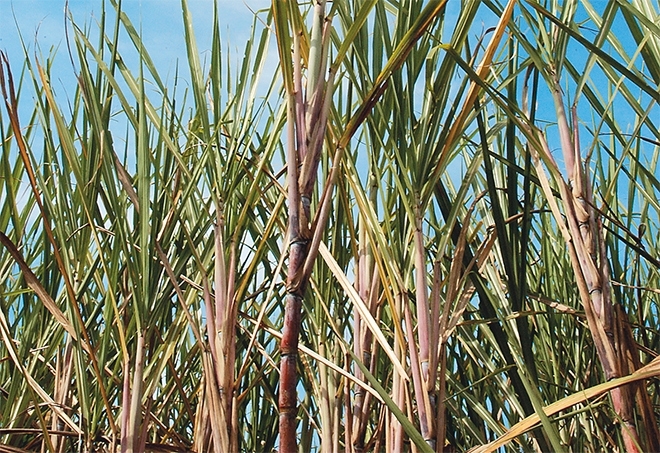

Plant accumulates sugars between sixth and twelfth months of growth while gradually reducing leaf photosynthesis, according to study by Brazilian scientists (photo: Eduardo Cesar / Pesquisa FAPESP)
Plant accumulates sugars between sixth and twelfth months of growth while gradually reducing leaf photosynthesis, according to study by Brazilian scientists.
Plant accumulates sugars between sixth and twelfth months of growth while gradually reducing leaf photosynthesis, according to study by Brazilian scientists.

Plant accumulates sugars between sixth and twelfth months of growth while gradually reducing leaf photosynthesis, according to study by Brazilian scientists (photo: Eduardo Cesar / Pesquisa FAPESP)
By Elton Alisson | Agência FAPESP – Sugarcane culms can accumulate such large amounts of biomass and sucrose during their development that the crop has become the most widely used in the world to produce sugar and ranks second among the preferred raw materials for ethanol production.
It is well known that biomass and sucrose accumulation in sugarcane is derived from the processing of metabolites such as nonstructural carbohydrates (NSCs) produced by photosynthesis during the day, but exactly how environmental conditions and the stage of plant development influence the production of NSCs and affect sugarcane growth is poorly understood.
Some answers are presented by researchers at the University of São Paulo’s Bioscience Institute (IB-USP) in Brazil in a study published in the journal Functional Plant Biology.
The research was carried out under the aegis of the National Institute of Science and Technology for Bioethanol (INCT Bioethanol), one of the INCTs supported by FAPESP in partnership with the National Council for Scientific and Technological Development (CNPq) in São Paulo State. Its findings could contribute to the development of strategies to increase biomass production in sugarcane.
“For the first time, we described the behavior of sugarcane in the field by day and night throughout the development cycle. We made several important and strategic discoveries in the direction of our goal of producing ‘supercane’ [a fast-growing variety that accumulates more biomass and fiber than conventional sugarcane],” said Marcos Buckeridge, a professor at the University of São Paulo’s Bioscience Institute (IB-USP) and a coauthor of the study, in an interview given to Agência FAPESP.
The researchers monitored a field of sugarcane during a complete growth cycle, collecting data 24 hours per day for 12 months, on a farm in Piracicaba, São Paulo State. They analyzed parameters such as leaf gas exchange and accumulation of NSCs at different stages of plant development.
The results of the analysis showed that sugarcane plants transition from growth mode to storage mode between about the third and the sixth months of development.
Photosynthesis rates are highest until the third or fourth month. During this period, the plant forms a functional canopy with a certain number of leaves. After reaching this stage and until the sixth month of development, for every leaf produced by the plant, another leaf, usually below the canopy, begins to age and become senescent, so that the number of leaves remains roughly the same.
From the sixth month onward, the plant stores sugars in the culm and roots, storing starch in the leaves until the twelfth month. During this stage, photosynthesis practically ceases. At the end of this stage, the plant is ready to be harvested for use in sugar and ethanol production.
“We knew sugarcane accumulated sucrose during the development stage, between months six and 12, but our study found this happens at the same time as a gradual decrease in photosynthesis by the leaves, where a very large amount of starch is stored by month 12,” said Amanda Pereira de Souza, who did postdoctoral research at IB-USP with a scholarship from FAPESP and is first author of the article.
The researchers also found that the sugars stored in the roots of cut sugarcane and left in the ground for regrowth after ratooning help regenerate the plant by fueling the initial part of its new development cycle.
More sucrose and starch
Another discovery was that sugarcane leaves sometimes keep stomata open at night to absorb water in the small hours, when humidity levels are higher. In the study, this was the case during the development stage between the sixth and ninth months, when rainfall decreased and photosynthesis was reduced. Stomata are microscopic pores that enable the plant to absorb water and carbon dioxide for photosynthesis.
“We think this nocturnal stomatal conductance may be related to a physiological mechanism for protection of the plant against drought,” Buckeridge said.
He added that detection of the transition from growth to sucrose storage between months three and six of development opens up the prospect of activating and deactivating genes that control the process of sugar storage in different parts of the plant.
“Understanding how each organ controls the accumulation of sugars in the same plant serves as a basis for developing a sugarcane variety with more leaf sucrose or more culm starch. Both strategies could be worth pursuing in different situations,” Buckeridge said.
The discovery that sugarcane leaves absorb water through stomata at night during the dry season could contribute to the identification or development of varieties that are more resistant to drought stress.
“This opens up a range of new opportunities to explore the effects of drought on sugarcane, including aspects relating to its response to climate change,” Buckeridge said.
The Functional Plant Biology article “Diurnal variation in gas exchange and nonstructural carbohydrates throughout sugarcane development” (doi: 10.1071/FP17268) by Amanda P. De Souza, Adriana Grandis, Bruna C. Arenque-Musa and Marcos S. Buckeridge can be retrieved from: publish.csiro.au/FP/FP17268.
Republish
The Agency FAPESP licenses news via Creative Commons (CC-BY-NC-ND) so that they can be republished free of charge and in a simple way by other digital or printed vehicles. Agência FAPESP must be credited as the source of the content being republished and the name of the reporter (if any) must be attributed. Using the HMTL button below allows compliance with these rules, detailed in Digital Republishing Policy FAPESP.





